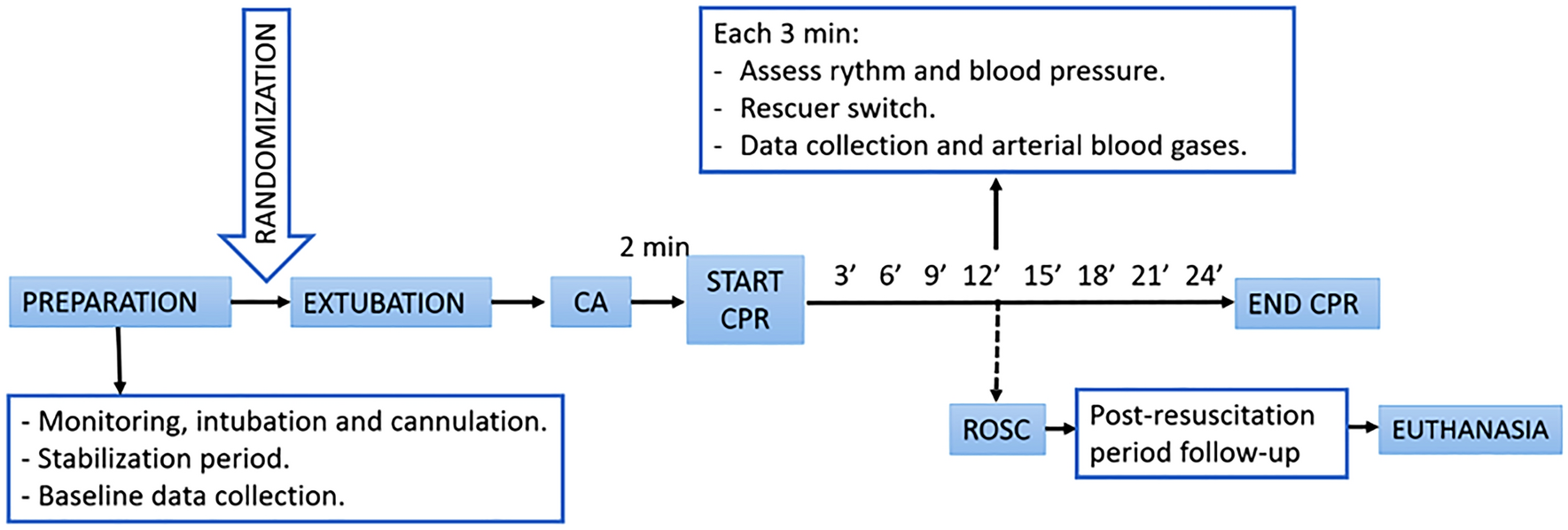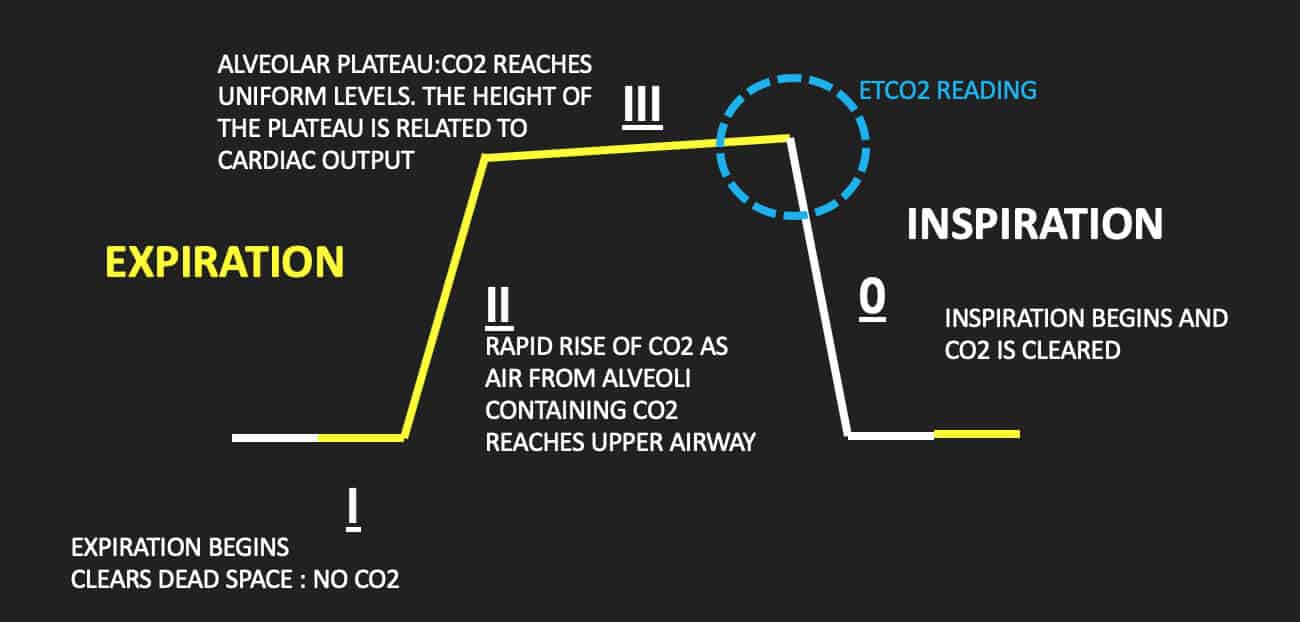end tidal co2 range in cardiac arrest
Cardiac arrest diminishes cardiac output and therefore decreases elimination of carbon dioxide CO 2 from the lungs. Bobrow MD Daniel W.
Emdocs Net Emergency Medicine Educationcapnography In The Ed Emdocs Net Emergency Medicine Education
November 11 2012.

. The first aim of the study was to investigate whether arteriolealveolar carbon dioxide difference AaDCO2 which is calculated using blood gas parameters and end-tidal carbon dioxide EtCO2 which is measured by capnography could be used as prognostic markers for patients with cardiac arrest in which ROSC is provided. Pierre Kory Laura OBrien RN CNS. A prospective observational study using a convenience sample.
These additional variables should be incorporated in termination of resuscitation algorithms in the prehospital setting. CO2 will decrease prior to a cardiac arrest in patients that are intubated in an intensive care setting. Increasing CO2 during CPR can also indicate the return of spontaneous circulation.
MEASURING END-TIDAL CO 2 LEVELS DURING CARDIAC ARREST Presentation for MSBI Nurses Prepared by Dr. We experienced a case of cardiac arrest associated with CO 2 gas embolism due to rupture of the hepatic. Predicting likelihood of return of spontaneous circulation ROSC in that a persistently low ETCO2 tends to predict death whereas a high or rising ETCO2 is associated with a higher chance of ROSC.
CO 2 levels were significantly lower in cardiac arrest patients when compared with hypotensive patients 1 2 3 and 4 hours prior to a cardiac arrest see Table 1. In fact its commonly called the. E T CO 2 was kept within the range of 30-35 mmHg with a respiratory rate of 15 breathsmin a tidal volume of 450 ml and an inspiration.
1031091090312720151115929 To link to. In addition a decrease in the EtCO2 during resuscitative events of 25 was associated with a. Association between Prehospital CPR Quality and End-Tidal Carbon Dioxide Levels in Out-of-Hospital Cardiac Arrest Prehospital Emergency Care DOI.
Because impaired circulation during arrest causes CO2 to build up in the bloodstream the initial ETCO2 reading may initially be higher than the normal 35-45 mm Hg range as it gets washed out of. A prospective observational study. After 20 minutes of CPR death occurs if ETCO2 is consistently below 10 mmHg with 100 sensitivity and specificity 15.
Capnography can also let healthcare providers know if the patients heart starts working again on its own. End-tidal carbon dioxide monitoring in cardiac arrest. End-tidal carbon dioxide cannot be used to rule out severe injury in patients meeting the criteria.
In one of largest studies to date of prehospital capnography in cardiac arrest an initial EtCO2 10 mmHg 13 kPa was associated with an almost five-fold higher rate of return of spontaneous circulation ROSC. An increase in etCO2 by 5 appears to have reasonable sensitivity 71-91 and specificity 94-100 for fluid responsiveness in two studies of patients breathing passively on the ventilator. End-tidal carbon dioxide monitoring in cardiac arrest.
Measuring end-tidal CO2 in cardiac arrest patients is helpful for. Levine RL Wayne MA Miller CC. End-Tidal CO2 as a Predictor of Cardiac Arrest Survival.
Expiration ratio of 1. End-tidal carbon dioxide monitoring in cardiac arrest Acad Emerg Med. Goals of this investigation.
Murphy MD Bentley J. Although the normal range for CO2 should be. The purpose of this systematic review is to evaluate the prognostic value of ETCO2 during cardiac arrest and to explore whether ETCO2 values could be utilised as a tool to predict the outcome of resuscitation.
End-tidal carbon dioxide and outcome of out-of-hospital cardiac arrest. End-tidal carbon dioxide ETco 2 monitoring provides valuable information about CO 2 production and clearance ventilation. End tidal carbon dioxide CO2 correlates with cardiac output during cardiopulmonary resuscitation in cardiac arrest patients.
End-tidal CO2 may be useful here as an easily and immediately measurable index of changes in cardiac output. If a patients heart stops and a patient goes into cardiac arrest end-tidal CO2 monitoring can help healthcare providers determine if chest compressions are being performed adequately. Kolar M Krizmaric M Klemen P Grmec S.
To assess the prognostic value of initial end-tidal CO2 pressures PETCO2 during CPR in patients with out-of-hospital cardiac arrest OHCA. Also called capnometry or capnography this noninvasive technique provides a breath-by-breath analysis and a continuous recording of ventilatory status. An accurate early predictor of the outcome of resuscitation is needed.
Studies have shown that in patients who had ETCO2 of 10 mmHg or less cardiac arrest was associated with death 13 14. In clinical observational studies mean ETCO 2 levels in patients with ROSC are higher. Capnography has been used extensively during cardiac arrest situations when there is a need to do CPR.
Spaite MD Chengcheng Hu PhD Robyn McDannold MS Tyler F. An initial EtCO2 10 and the absence of a falling EtCO2 25 from baseline were significantly associated with achieving ROSC in out-of-hospital cardiac arrest. Cardiac Arrest Ryan A.
Mean CO 2 values were significantly higher in normal patients when compared with those in patients who had a cardiac arrest 3018 493 vs. Because it splits into CO2 and H20 So if rises after NaHCO3 do not. Literature search was performed using Medline and EMBASE.
Primary service area of an advanced life support ALS ambulance service including a city with a population of 70745 and the. Successful resuscitation will show an increase in end tidal carbon dioxide ETCO 2. Measurement of end-tidal expiratory pressure of carbon dioxide ETCO 2 using capnography provides a noninvasive estimate of cardiac output and organ perfusion during cardiac arrest and can therefore be used to monitor the quality of CPR and predict return of spontaneous circulation ROSC.
BackgroundPhysiology 2 Monitoring end-tidal CO 2 ET-CO 2 provides instantaneous information about ventilation how effectively CO. End tidal CO2 in cardiac arrest. Partial pressure of end-tidal carbon dioxide successful predicts cardiopulmonary resuscitation in the field.
The patient was placed in the Trendelenburg position during the LAR.

Effects Of Airway Management And Tidal Volume Feedback Ventilation During Pediatric Resuscitation In Piglets With Asphyxial Cardiac Arrest Scientific Reports

Pulse Oximetry Waveform A Non Invasive Physiological Predictor For The Return Of Spontaneous Circulation In Cardiac Arrest Patients A Multicenter Prospective Observational Study Resuscitation

End Tidal Carbon Dioxide Etco2 And Ventricular Fibrillation Amplitude Spectral Area Amsa For Shock Outcome Prediction In Out Of Hospital Cardiac Arrest Are They Two Sides Of The Same Coin Resuscitation

Abstract 223 End Tidal Carbon Dioxide Levels Predict Cardiac Arrest Circulation

Use Capnography For A Patient In Cardiac Arrest Capnoacademy Capnoacademy

Average Etco2 Kpa During Cpr In Patients With Or Without Rosc Download Scientific Diagram

Waveform Capnography In The Intubated Patient Emcrit Project

Clinical Rationale Textbook Hey Guy I Have Been Asked To Talk About Capnography Or Etco2 Monitoring With This Now Being Introduced For Als In Cardiac Arrest Outside Of Cardiac Arrest This

Updates In Cardiac Arrest Resuscitation Emergency Medicine Clinics

Capnography Cheat Sheet Nclex Quiz Respiratory Therapy Student Nursing Cheat Nursing Cheat Sheet

Quantitative Waveform Capnography Acls Medical Training

The Role Of Etco2 In Termination Of Resuscitation Jems Ems Emergency Medical Services Training Paramedic Emt News

Average Etco2 Kpa During Cpr In Patients With Or Without Rosc Download Scientific Diagram

The Use Of End Tidal Carbon Dioxide Etco2 Measurement To Guide Management Of Cardiac Arrest A Systematic Review Resuscitation
Effectiveness Of Cpr And Prognosis In Cardiac Arrest Capnography Training

The Association Between End Tidal Co2 And Return Of Spontaneous Circulation After Out Of Hospital Cardiac Arrest With Pulseless Electrical Activity Resuscitation

Etco2 Valuable Vital Sign To Assess Perfusion The Airway Jedi

A Time Capnogram Of A Patient With Airflow Obstruction Illustrating A Download Scientific Diagram
